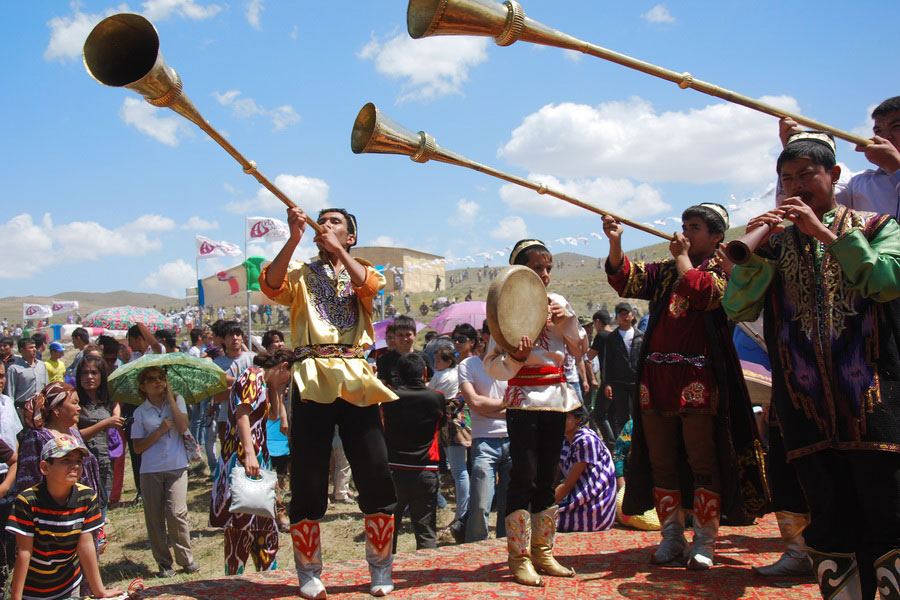
For thousands of years, music has accompanied the Uzbek people through every stage of life - it has inspired joy at celebrations, offered comfort in hardship, and preserved for future generations the melodies of songs, makoms, and dastans – precious forms through which we glimpse the spirit and history of the nation.
Music played such a central role in Uzbek society that it often drew people together in city squares, where they would listen for hours to the performances of celebrated musicians. Composer and ethnographer Viktor Uspensky, who came to Uzbekistan in the early 20th century, was struck by the people's deep connection to their musical heritage. In his memoirs, he recalled that in 1923, during the Sail festival in Bukhara, “...a crowd of thousands listened to the singing of the famous singer Ata-Jalal Nasyrov in complete silence...”
Now, more than a century later, Uzbekistan’s love of music remains just as strong. Hundreds of concerts and festivals are held across the country each year. Traditional Uzbek music is performed in both its original form and in dialogue with contemporary styles, while new compositions and popular genres continue to emerge - together forming the diverse and dynamic landscape of modern Uzbek musical culture.
The History of Traditional Uzbek Music
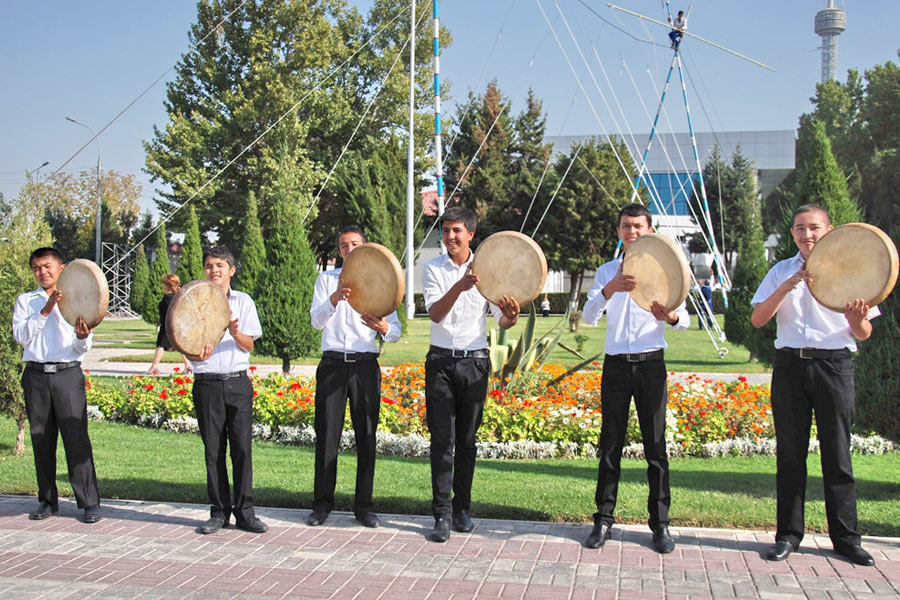
The history of Uzbek music stretches far into the past. Archaeological evidence shows that musical culture already existed here in the early centuries of our era.
Images of musicians and musical instruments have been discovered at numerous ancient and medieval sites, including the archaeological complex of Airtam (near Termez in Surkhandarya), the fortress of Toprak-Kala (in ancient Khorezm, present-day Karakalpakstan), Kafir-Kala (near Samarkand), the settlement of Afrasiab (Samarkand), and Varakhsha (near Bukhara).
Many of these artifacts are housed in Uzbek museums, while others - such as the 1st–2nd century Airtam frieze depicting Bactrian musicians and 6th–7th century Sogdian figurines - are part of the collection of the State Hermitage Museum in St. Petersburg.
The further development of music in this region is documented in the treatises of great Eastern scholars and musicians. Among the most influential works are The Great Book of Music (10th century) by Abu Nasr al-Farabi; musical sections from Avicenna’s The Book of Healing and The Book of Knowledge (11th century); The Book of Circles (13th century) by Safi al-Din al-Urmavi; writings on music by Abdurahman Jami (15th century), Najm al-Din al-Kawkabi (16th century), and Darwish Ali (17th century); as well as Uzbek Classical Music and Its History by Abdurauf Fitrat (20th century).
If you happen to open one of these treatises and find no separate section on music, do not be surprised - in the medieval tradition, music was considered a branch of mathematics. This is because sound and melody were understood through numerical properties such as vibration frequency, and their study involved precise calculations.
At the same time, music’s aesthetic dimension was also deeply explored. Many scholars wrote about its beauty and therapeutic power. Avicenna, for instance, examined the psychological effects of specific melodies and rhythms. Thanks to these ancient texts, we also gain insight into the musical life of earlier eras - their leading performers, the instruments they played, and the structures of those instruments.
Characteristics of Traditional Uzbek Music
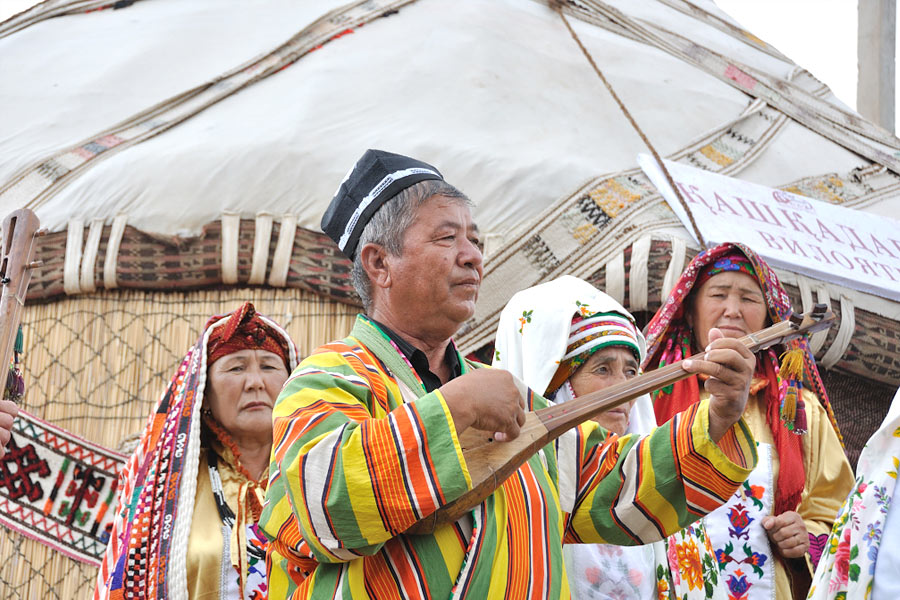
Like the music of many other Eastern cultures, Uzbek music is monodic in nature – that is, it is performed in unison. This does not mean it is played by a single musician, but rather that even in ensembles, all performers play the same melody, often with slight variations or rhythmic embellishments.
This structure does not imply simplicity. On the contrary, Uzbek monophony is quite sophisticated, rich in ornamentation, micro-intonations, and subtle dynamic shifts. These elements give the melody a vivid, flowing quality - much like the intricate curves of Eastern decorative art.
Uzbek melodies are often supported by complex rhythms organized into repeating patterns known as usuls. These rhythmic cycles are performed on percussion instruments, most commonly the round frame drum known as the doira.
Uzbek music features a wide range of instruments, each with its own distinct timbre and performance technique. Among the most prominent are the bowed string instruments ghijak and sato; plucked strings such as the dutar, tanbur, and the UNESCO-recognized rubab; the hammered string instrument chang; wind instruments like the nay, karnai, and surnai; and percussion instruments including the doira and nagora.
Musical traditions differ across regions of Uzbekistan, with variations in genres, instruments, and stylistic nuances. The main regional styles include Bukhara-Samarkand, Fergana-Tashkent, Khorezm, and Kashkadarya-Surkhandarya. Within the latter is the distinctive Baysun region (Surkhandarya), whose cultural heritage – including its music – was one of the first elements of Uzbek intangible culture to be included in the UNESCO list.
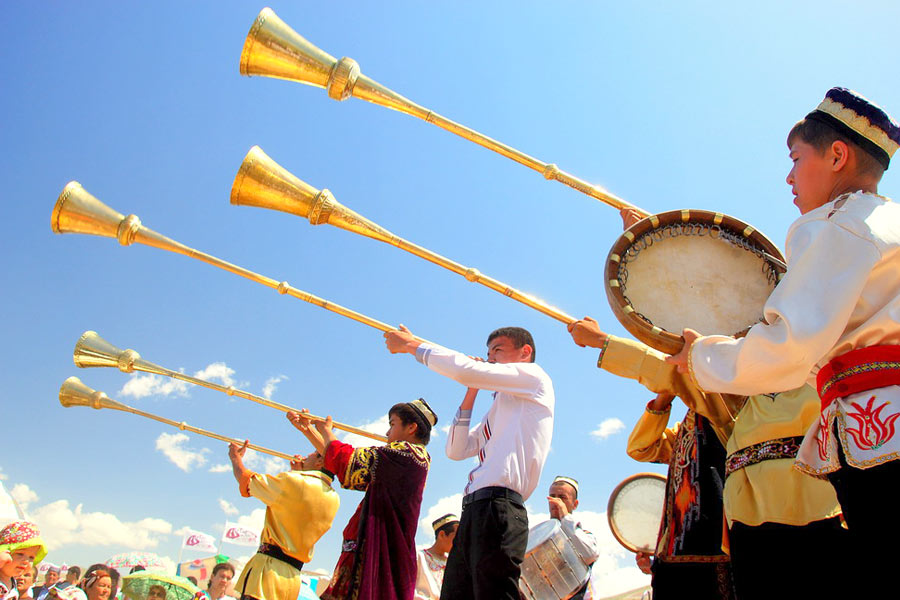
A defining feature of traditional Uzbek music is its oral transmission. Until the 20th century, music was passed down exclusively through the ustoz-shogird (master-apprentice) tradition. Aspiring musicians would train for 10 to 15 years before being recognized as hafiz – guardians of ancient musical knowledge. This long period of study was necessary due to the sheer scale of the repertoire. For example, the Shashmakom cycle alone consists of over 250 short pieces, all of which had to be memorized and preserved in order to be passed on to the next generation.
Written notation was introduced only in the 20th century. Before that, the only known example of musical transcription was the tanbur notation system, invented in the 19th century by Khorezmian musician Kamil Khorezmi. Thanks to this method, accurate records of tanbur music from that era have survived.
In the 20th and 21st centuries, with the advancement of technology and the influence of Western traditions, most forms of traditional Uzbek music were recorded. Today, they are available in the form of sheet music and audio files, making them accessible for preservation and study.
Uzbek musical genres are traditionally divided into two categories: folk music, which is simpler and created by non-professional musicians (typically short folk songs), and classical music, which is more intricate and developed by master performers. The crown jewel of professional Uzbek music is the makom tradition.
Uzbek Songs
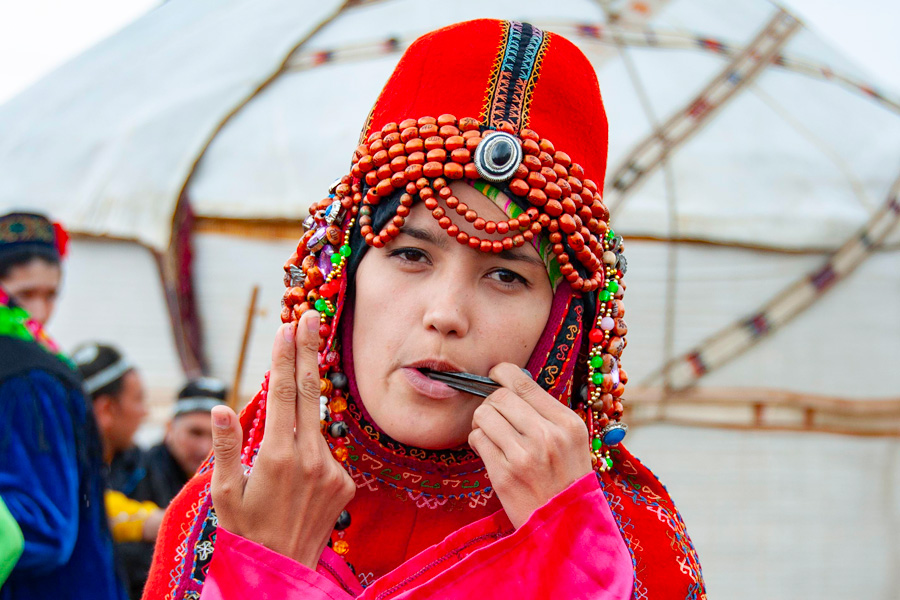
Traditional Uzbek songs are generally divided into two types. The first type is linked to specific events and rituals. These include the lullaby Alla, the wedding song Yor-yor, the mourning song Yigi, the work song Maida, and others.
The second type is more universal and can be performed at any time. These include songs in genres such as terma, ashula, katta ashula, koshuk, lapar, and yalla.
Terma and koshuk are considered simpler styles, while yalla and ashula are more intricate. Ashula is characterized by lyrical themes, a melodious tune, and a complex rhythmic structure. Yalla tends to be more energetic; it is performed by a choir and a soloist, who often adds expressive movement or dance to the singing.
The lapar genre is especially distinctive, featuring a playful or humorous song-dialogue between two performers.
The most sophisticated and technically demanding form of Uzbek song is katta ashula (literally "great" or "sublime song"). These compositions explore themes of love, philosophy, and religion. Originating in the Fergana Valley, katta ashula is usually performed by a small group of two to five singers. A unique aspect of the performance is the use of lyagans (large decorative plates or trays), which the singers hold in front of them. This has earned the genre the nickname patnusaki ashula, meaning "song with a tray".
Renowned for its expressive depth and cultural value, katta ashula has been inscribed on UNESCO’s Representative List of the Intangible Cultural Heritage of Humanity.
Dastans
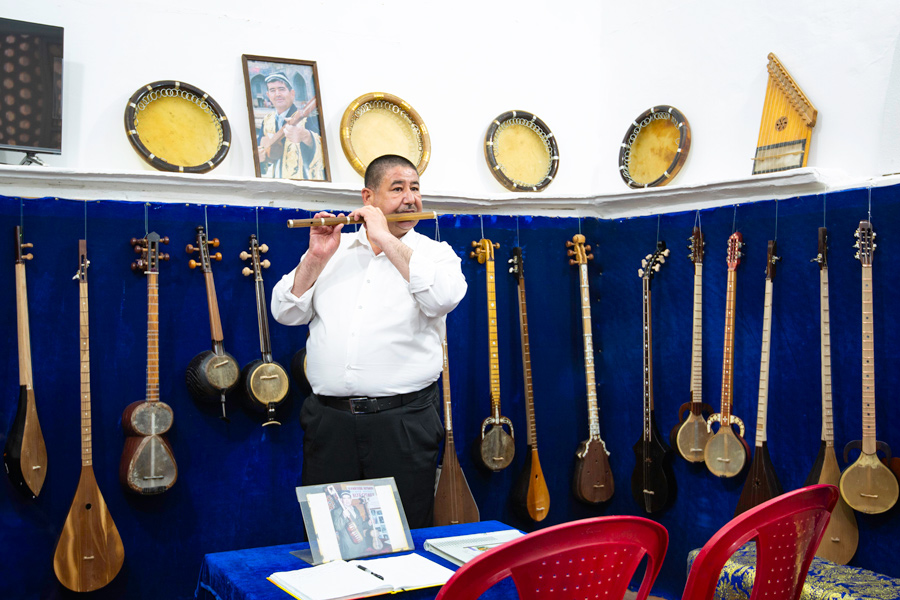
Long narrative poems about historical events, heroic deeds, or love stories are among the most cherished forms of Uzbek musical heritage. Famous examples include Alpamysh, Tahir and Zuhra, Kyrk-Kyz, and others. In Uzbekistan, these epic tales are performed by storytellers called bahshi, while in Karakalpakstan, the term zhirau is more commonly used.
Dastans are performed in various regional styles. In Samarkand, the style is more recitative and conversational; in Khiva, the delivery is more melodic, with music playing a prominent role. In Surkhandarya, Kashkadarya, and Karakalpakstan, the performance style blends melody with spoken narration and often features a distinctive form of throat singing - one of the most intricate and unique vocal techniques.
Instrumental accompaniment is also common in dastan performances, typically featuring the dutar, dombra, kobuz, gijak, or doyra.
Makoms
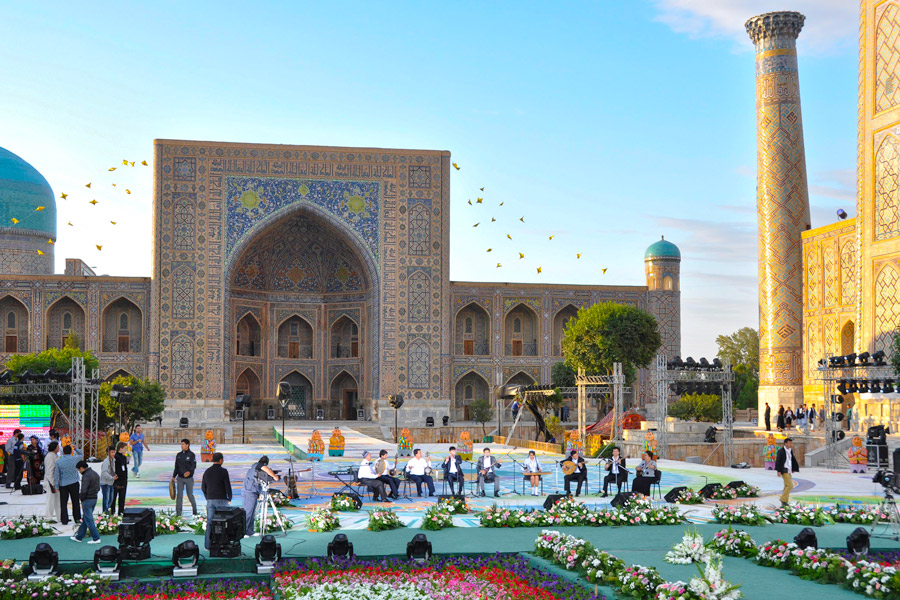
Makoms represent the pinnacle of Uzbek classical music. The most renowned are those of the Bukhara cycle known as Shashmakom - an Uzbek-Tajik tradition inscribed on UNESCO’s Representative List of the Intangible Cultural Heritage of Humanity. This intricate and highly developed system of instrumental and vocal compositions evolved over centuries, taking its present form around the 18th century.
Shashmakom (literally “six makoms” in Tajik) is a suite of six extensive musical cycles, each with its own unique mood, structure, and modal system. These principal makoms are Buzruk (“great”), Rost (“true” or “correct”), Navo (“melody”), Dugoh (“two tones”), Segoh (“three tones”*), and Irok (or Iraq, named after the region).
Each makom is traditionally divided into two main parts: the instrumental section (muskilot) and the vocal section (nasr). The vocal components often feature the poetry of classical Uzbek literary figures such as Navoi, Jami, Mashrab, and others.
In addition to the renowned Shashmakom, Uzbekistan is home to two other major makom traditions: the Khorezm makoms, which developed under the influence of Bukhara’s Shashmakom, and the entirely distinct Fergana-Tashkent makom cycle, known for its unique musical style.
Today, live performances of makom can still be heard at concerts and cultural festivals. The largest of these is the International Festival “Sharq Taronalari” (“Melodies of the East”), held biennially in late August in Samarkand. The 13th edition of the festival, in 2024, welcomed over 300 participants from 75 countries, along with thousands of guests who gathered to experience this vibrant and captivating musical celebration.
Contemporary Musical Culture of Uzbekistan
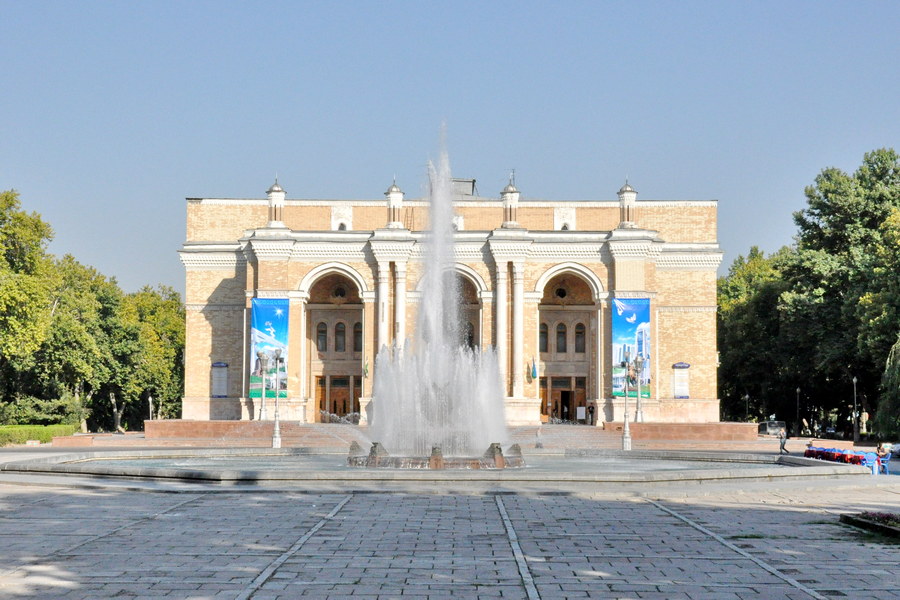
At the end of the 19th century, Turkestan became part of the Russian Empire, leading to the gradual introduction of European influences into Uzbek culture, including music. Musical notation was introduced, ensembles and orchestras were formed, theaters began to appear, and academic institutions such as music schools and conservatories were established.
Over time, Uzbekistan’s major cities, especially Tashkent, developed into vibrant musical hubs, hosting regular concerts and fostering the growth of all academic musical genres.
Opera and Ballet
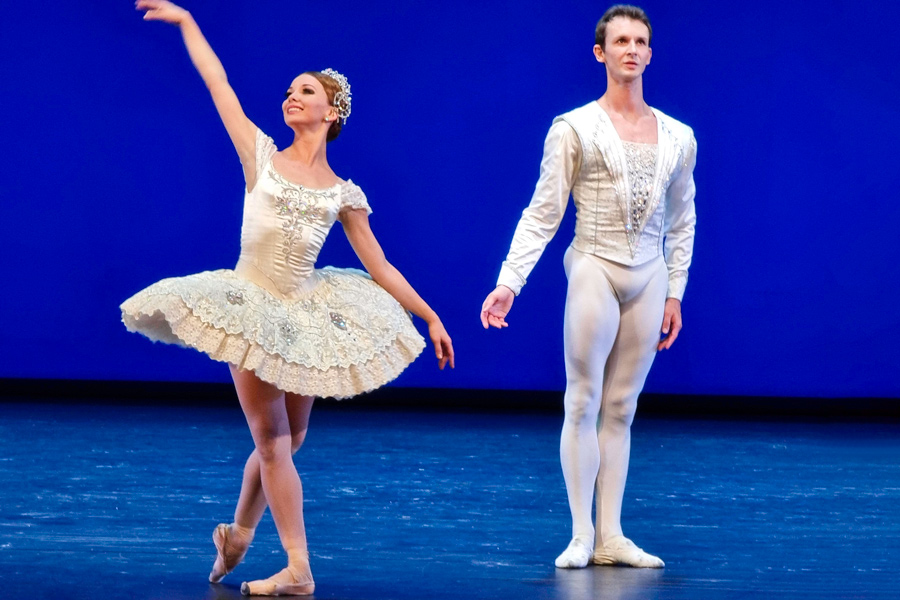
As early as the first half of the 20th century, composers began creating staged works inspired by the history and culture of Uzbekistan. Among the first was Buran (1939) by Mukhtar Ashrafi and Sergei Vasilenko, the first Uzbek opera based on a historical theme. This was followed by Leili and Majnun (1940), an opera based on Navoi’s poem, composed by Tolibjon Sadykov and Reinhold Glière. Later came The Pranks of Maisara (1959) by Suleiman Yudakov, based on the well-known play by Hamza, which has remained beloved by audiences for over half a century.
Contemporary Uzbek operas include Sadokat (2015) by Rustam Abdullaev, dedicated to the poet Zulfiya and her devotion to Hamid Alimjan; Hamsa (2017) by Mustafa Bafoev, based on Navoi’s celebrated collection of five poems; and Kumush (2019) by Mirhalil Makhmudov, inspired by the classic Uzbek novel Bygone Days by Abdullah Qadiri.
Uzbek ballets convey the country’s culture and history through symbolic and expressive movement that transcends language. Notable ballets by Uzbek composers include Amulet of Love (1969) by Mukhtar Ashrafi, a tragic tale of love between a Bukhara youth, Mirza Izzat, and an Indian girl, Sonni; Tomiris (1984) by Ulugbek Musaev, centered on the legendary queen of the 6th century BC; and Humo (2005) by Anvar Ergashev, a fantastical ballet about the mythical Zoroastrian bird Humo and the lovers Zargare and Zuleikha.
Opera and ballet performances are staged at the Alisher Navoi Theater in Tashkent, a landmark building whose distinctive architecture draws immediate attention. Built in the mid-20th century, it was designed by prominent architects led by Alexei Shchusev, with artistic contributions from painter Chingiz Akhmarov and craftsmen from across Uzbekistan.
In addition to Uzbek productions, the theater presents global classics such as Rigoletto, Aida, and La Traviata by Giuseppe Verdi; Carmen and The Pearl Fishers by Georges Bizet; Eugene Onegin and The Queen of Spades by Pyotr Tchaikovsky; and ballets such as Giselle by Adolphe Adam, The Nutcracker, and Swan Lake by Tchaikovsky.
Uzbekistan’s Evolving Concert Culture
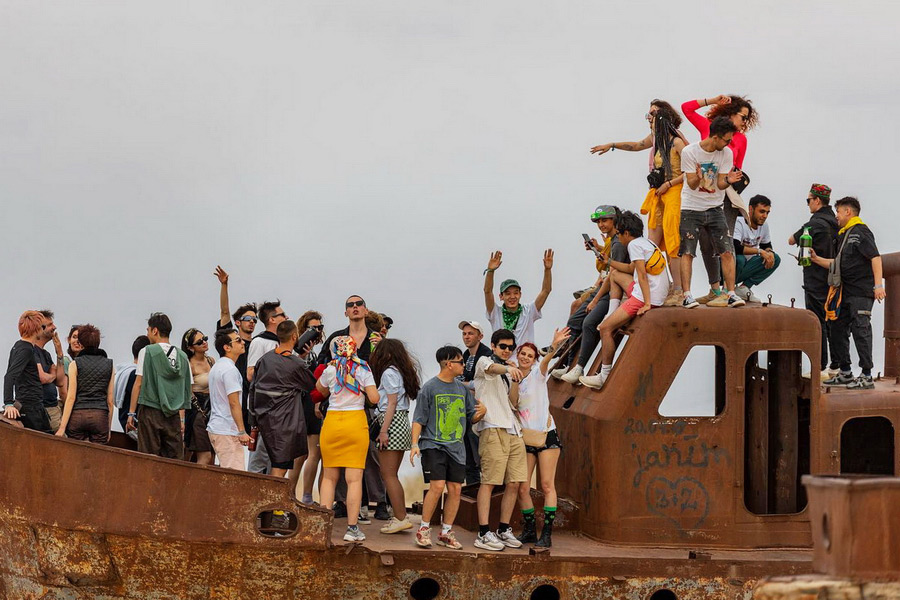
Photo: www.stihia.org
In recent years, largely thanks to the efforts of the Uzbekistan Art and Culture Development Foundation, Tashkent and other major cities have emerged as vibrant centers of international musical culture. World-renowned artists now regularly perform in Uzbekistan, including Russian pianist Mikhail Pletnev, Chinese-American pianist Lang Lang, pianist and composer Ludovico Einaudi, conductor Teodor Currentzis with his orchestra, violinist Maxim Vengerov, and vocalist Andrea Bocelli.
The works of Uzbek composers play a vital role in the country’s concert scene. The classics of Uzbek symphonic music include compositions by Mirsadik Tadjiev, Mirhalil Makhmudov, Tulkun Kurbanov, Ikram Akbarov, and Felix Yanov-Yanovsky, alongside more recent works by Rustam Abdullayev, Khabibullo Rakhimov, and Mustafa Bafoev. Their symphonies, symphonic poems, overtures, and suites are regularly performed at concerts and festivals across Uzbekistan.
The country also hosts several major events dedicated to academic and classical music. These include international symphonic music festivals, Classical Music Fest (2025), and the French Music Festival (2025).
Concerts in contemporary genres such as rock, rap, pop, jazz, and electronic music are equally popular. The annual Iosis Fest has long been Uzbekistan’s leading rock music festival. Jazz compositions by Uzbek groups like Jazzirama, along with performances by international musicians, can be heard at the International Jazz Festival, held annually under the auspices of UNESCO. Fans of electronic music gather at the Sublimation Fest in Tashkent and at Stihia, a unique festival held in Muynak at the bottom of the dried-up Aral Sea.

